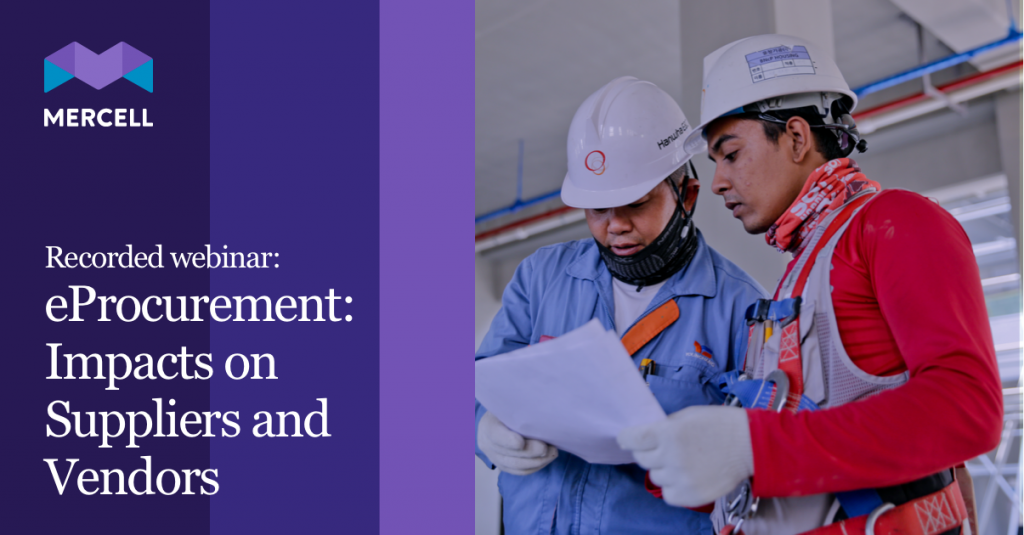Supply Chain Technology: History & Impact
Every day, new technologies transform how we live and work, and for supply chain and procurement managers, supply chain technology has led to dramatic change.
Every day, new technologies transform how we live and work. For supply chain and procurement managers, supply chain technology has led to dramatic change. Following and understanding all of the development in this area can be a complex task, synthesizing the information and implementing new technology can be even more challenging.
At Mercell, working with public sector agencies, we occasionally see a level of reticence with regard to new technology implementation. To that end, we want to help unpack the impact of technology on the supply chain.
The History of Supply Chain Management
Prior to the 1960s, logistics management was primarily decentralized. Largely, organizations hadn’t recognized the value and cost savings that could be unlocked by logistics. Weak internal linkages between functions made it a bit challenging to put the pieces together.
In the 70’s leaders began to bring in Total Cost Management (TCM) to take a more holistic and systematic view of costs across their businesses and product lifecycles. If you are looking at total lifecycle costs, the importance of logistics starts to come into focus. This renewed focus, along with a contemporaneous energy crisis as well as the development of computer networks led to a more centralized logistics.
The 1980’s saw logistics management taking on a more strategic role within organizations. It was at this time that optimized logistics became viewed as an area of and opportunity for competitive advantage. That sense continues today.
In the 90s, major advancements in computing and the internet coincided with the development of new models for Supply Chain Management. This laid the groundwork for today’s distributed logistics and many of the major technological advancements that the field is experiencing today.
The Technology-enabled Supply Chain
When we talk about a tech-enabled supply chain, we are looking at the points of interaction between your suppliers and your customers. These suppliers may be new or existing suppliers, they may be local or international, or from diverse backgrounds. For municipalities, those customers may be an end-using department, for school districts, they may be your teachers and students.
A technology-enabled supply chain enables these stakeholders. It makes communication, engagement, and fulfillment as easy as possible with the help of the latest tools and tech.
A system like this touches many departments. Asset Management, Engineering, HR, Logistics, and Finance are just a few. For procurement and supply chain professionals, this interconnectedness is an opportunity. The tech-enabled supply chain serves as a hub by which these leaders can derive broad data and make the strategic decisions that can impact their organizations and their bottom lines in a big way.
The Latest Supply Chain Technology
The pace of technological growth and innovation is accelerating. This can make it a challenge to pinpoint the ways that our systems are starting to change, and then adapt to that change. The Supply Chain has transformed, is currently transforming, or is set to transform as a result of some key technologies:
- The Internet of Things (IoT) – Referring to the global network of interconnected devices, IoT’s most important output is data. And with projections of over 21 billion connected devices globally by 2025, always-on data streams will feed a deep well of insight and optimization opportunities for supply chain managers.
- Data, Machine Learning, and AI – Planning, scheduling, spend analytics, logistics optimization, and forecasting are all areas where AI (once it’s more broadly adopted) could have an impact.
- eProcurement and Digitization – Cutting costs, reducing opportunities for errors, boosting collaboration, dramatically speeding up the process, and accumulating data for improved insight and decision making. Digitization projects like eProcurement implementation are absolute game changers for public agencies.
Mercell’s Source-to-Contract platform completely digitizes procurement. Schedule some time to discover how it can help your agency.
- Drones – Rocket-man Jeff Bezos said in 2013 that drones will be flying to customers’ homes within 5 years. Regulatory hurdles delayed the timeline, but the FAA has given the green light to Amazon, UPS, and Google. UPS is experimenting with from-truck drone launch. All of this is changing last-mile delivery.
- LIDAR and Driverless – LIDAR remote sensing technology has been steadily improving in recent years and its impacts will be broad. For Supply Chain, its largest impact may be on the improvement and further implementation of driverless vehicle technology. Driverless should dramatically impact long-distance shipping rates as well as logistics for last-mile delivery.
- Warehouse Automation – Automation of warehouses has already begun to show efficiencies in time and reliability, cutting labor costs and providing consistent results.
What’s next? Is automation a risk?
The most common concern voiced in discussions of new technologies, especially automation, is the fear of personnel getting replaced by those technologies. This fear is not entirely unfounded. In discussing the topic, Dr. Randy Bradley notes our willingness to not only use, but follow the lead our tech sets:
“Studies have shown that we have no trouble taking advice from a device rather than a person.”
Dr. Randy Bradley, University of Tennessee
It is inevitable that technology and robotics will continue to augment the supply chain workforce. But while this may change the structure of our supply chain teams and operations, organizations will continue to need experienced procurement and supply chain professionals. For now, these professionals are still needed to steer the ship. And while these new technologies automate processes, what that does is give supply chain teams more opportunity for the kind of strategic thinking that makes them invaluable to their organizations. As Mary Iannuzzi from Michigan Manufacturing puts it:
“Technology shouldn’t make you irrelevant, it should make you better.”

